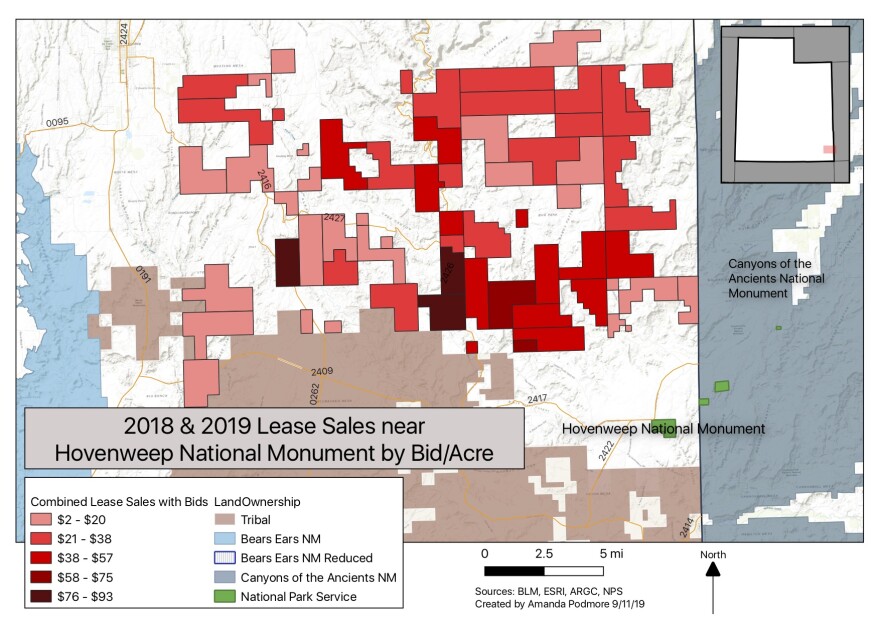Conservation and tribal groups are criticizing the Bureau of Land Management for its latest oil and gas lease sale of more than 70,000 acres of public land in Utah.
The sale, which occurred this week, brought in around $1.63 million, according to the BLM, more than half of which came from 32,027 acres in San Juan County.
The sale is the third since March 2018 to include land between Bears Ears and Canyon of the Ancients National Monument, much of which conservation groups say should not be leased.
“This area has more archaeological sites than any other area open to oil and gas drilling in the United States,” said Josh Ewing, director of Bluff-based conservation group Friends of Cedar Mesa.

The BLM does not survey land for cultural artifacts prior to offering it for lease, so there’s no way to know exactly what’s there. But Ewing pointed to reports from archaeologists who have worked in the area to back up his claim.
“Just to give you a sense, there are at least a dozen ancient community centers in this area that are larger than the largest site in Bears Ears National Monument,” he added.
According to the BLM, the leasing process ensures that drilling does not damage cultural artifacts. Prior to offering up a lease, the BLM takes public comments on the parcels to be sold. It can use those comments to place stipulations on the parcels, such as where drilling can and cannot occur.
BLM spokesperson Kimberly Finch said groups like Friends of Cedar Mesa can also protest the sale, once the parcels and stipulations are published.
“We may defer those parcels because an individual or party have raised important things to consider or clarify,” she said.
But Ewing said the BLM rarely withdraws land from a lease sale based on comments.
“They have yet to remove a single acre, a single great house, a single kiva, a single archaeological site out of any of these sales [in San Juan County],” he said.
All 19 of the parcels leased this week in San Juan County were protested, according to Finch, and the sales will not be final until those protests are resolved.
“Firesale Mentality”
Critics say the BLM is flooding the market with leases, which is driving prices down. Under the Trump administration, the BLM switched from quarterly lease sales that took place in different districts to quarterly statewide sales, which means that land in one district can come up for sale multiple times in one year.
Less than half of the land offered for lease this week at auction received a bid, according to statistics published by the BLM. The rest of the land is now available for lease at $1.50 an acre.
“It further demonstrates how BLM’s firesale mentality isn’t helpful. They’re just putting up everything and anything and hoping that it sells,” said Landon Newell, an attorney with Southern Utah Wilderness Alliance.

Oil and gas lease sales in places like New Mexico and West Texas have drawn up to $800 million in recent years, Newell added.
In addition to increasing the rate of lease sales, the Trump Administration also dropped the use of Master Leasing Plans, which were used by the BLM under Barack Obama to determine where oil and gas leasing is an appropriate use of public land. The plans sought to balance uses, according to Newell, and protected much of the archaeologically-rich public land in San Juan County.
The BLM withheld sensitive areas in San Juan County from leasing to oil and gas developers under Obama. But, without a Master Leasing Plan, much of the public land in San Juan County is now on the table for development. The BLM has offered parcels in San Juan County for lease three times since March 2018. And it will offer up 5,536 more acres for lease there this December.
“I like to draw the picture that they’re building a puzzle or mosaic of leases in this area,” Newell said. “Just picture them, every few months, completing a fourth of the puzzle.”
Greenhouse Gasses
While attempts to protect architecturally-rich areas from oil and gas development have mostly failed, arguments that oil and gas development on public lands contributes to global warming have held up in federal court.
Earlier this year, a federal judge in the District of Columbia stopped oil and gas leasing on 300,000 acres of public land in Wyoming in response to a case filed by conservation groups in 2016. The lawsuit claimed the BLM violated the National Environmental Policy Act by failing to consider the climate affects of leasing public land for oil and gas development, and that argument was upheld in court.
Conservation groups, including Southern Utah Wilderness Alliance, are using the same argument to sue the Bureau of Land Management over 130 oil and gas leases issued in Utah between 2014 and 2018. The lawsuit was filed Sept. 12 in U.S. District Court in Salt Lake City and asks the leases be withdrawn.
In a statement, lead plaintiff Southern Utah Wilderness Alliance claimed that oil and gas extracted from public lands accounts for nearly a quarter of all U.S. greenhouse gas pollution.
“The development of these leases will push us closer to the point of no return on climate, while sacrificing some of the most wild, scenic and culturally significant public lands in America,” Newell said.




